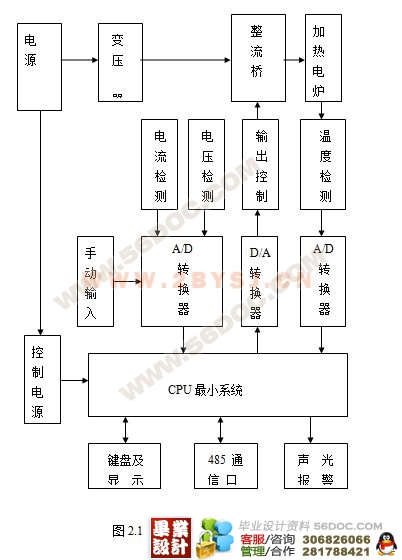摘 要
100kW微机控制单晶硅加热电源运用先进的计算机控制技术实现低电压大电流电源输出的功率调节,实现单晶硅加热电源的数字化控制。设计内容包硬件设计和软件设计两大部分,其中硬件设计包括温度设定值检测电路、晶闸管控制电路、CPU系统、远程通信接口、人机对话接口等部分,软件设计包括程序流程图以及具体程序设计。
在硬件部分,主电源经变压器降压后由六只可控硅组成的三相桥式全控电路;采用MAX197实现将模拟量信号变成数字量信号,由AT89C52和数据存储器6264构成CPU 系统,功率控制部分采用MAX508将数字量转换为模拟量控制触发电路,达到调节功率的目的;键盘、显示电路采用专用的8279芯片,通讯接口电路采用MAX487构成的485通信方式,与其他的仪器仪表作远距离通信,实现远程控制。
在软件设计部分,设计了主程序,自检程序,数据采集程序,数据处理程序,键盘控制中断服务程序,显示程序,功率调节程序等部分。软件设计采用了模块化的设计方法。
关键词:单晶硅;可控硅;单片机;加热电源
Abstract
“The 100kW microcomputer control monocrystalline silicon heating power source” has utilization the advanced computer control technology that realized the power regulation of low voltage and big electric current power source outputs , and monocrystalline silicon heating power source numerical control . The design includes two major parts, which are hardware design and the software design .The hardware design includes electric design of the temperature setting value examination, thyristor control circuit, CPU systematic, long-distance parts correspondence connection, man-machine conversation part and so on. The software design includes the program flow diagram and the concrete program design.
In the hardware part, the main power source voltage is dropped by transformer firstly, then used the all controls the electric circuit of the three-phase bridge type which is composed by six silicon-controlled; Using the MAX197 realizes that the simulate signal is transformed into the digital signal; the CPU system is consist of AT89C52 and the data-carrier storage 6264; Power control section uses MAX508 to transform the digital quantity into the simulation quantity control triggering electric circuit, and achieve the goal of regulating power; The keyboard and the display circuit use the special-purpose 8279 chips; The communication part electric circuit corresponds with other instrument measuring appliances by the 485 correspondence way that is make up MAX487, and up to the long-distance control.
In the software design part, have designed the master routine, the self-checking procedure, the data acquisition procedure, the data reduction program, the keyboard control interrupt service, the demonstration procedure, power regulation procedure and so on. The software design has used the modularized design method.
Key word: Monocrystalline silicon; Silicon-controlled rectifier; Monolithic integrated circuit; Heats up the power source
微机控制单晶硅加热电源应用于硅处理,本论文设计的具有计算机通讯功能的智能温控设备,它以单片机AT89C52为核心,采用一种高精度的温度检测电路,该电路具有分辨率高,精度高,误差小的优点,能够使系统得到较准确的温度采样值,键盘/显示由8279芯片进行管理,减轻了CPU的负担,提高了系统的速度。通信功能由RS-485通信接口芯片MAX487实现,能够高效的进行信息通讯。控制由晶闸管主电路及其触发电路完成,触发电路采用KJ系列芯片电路构成的触发脉冲振荡电路,本电路具有良好的触发性能。控制算法采用PID算法,可以满足较高的控温要求。
该电源控制系统测量精度高,可靠性好,抗干扰能力强,不但可以取代老式的电阻炉,还可以实现计算机网络控制,是现代工业控制领域中实用的智能化设备。
本电源采用面板显示,除了用简单的LED指示灯外,多用七段LED显示器来显示十进制数字和其他字符,面板显示字迹清晰、直观。本电源还具有很强的自测试和自诊断功能。它能测试自身的功能是否正常,如不正常还能判断故障的部位,并给出指示,大大提高了仪器工作的可靠性,给仪器的使用和维修带来很大方便。
本文研究内容:
通过对电力电子技术、检测技术、 单片机原理及应用、微机控制技术、数字模拟技术等相关知识的了解和掌握,运用微机等技术通过对晶闸管的控制来实现调压,在低压大电流条件下,输出的功率调节,实现单晶硅加热炉温度的自动控制。
本设计的具体内容如下:
1)加热电源总体方案确定
2)使用低压变压器400V/50V 100KW
3)控制温度设定值检测电路,手动优先,其次为4-20mA电流输入
4)晶闸管控制电路
5)CPU系统设计
6)远程通信口设计
7)加热电源运行参数显示
9)软件设计包括系统流程图和具体程序
系统总体设计方案
本论文设计为微机控制单晶硅加热电源,分别对主电路和控制电路进行了详
细的设计说明。微机控制单晶硅加热电源框图如图2.1所示。
其中主电路包括变压器个整流桥。控制电路包括控制电源、CPU系统、温度检测通道、键盘/显示接口电路、输出控制通道、通信接口、声光报警电路以及系统软件。
系统工作原理:主电路将电路380V降到50V经整流桥进行整流输出给加热炉。由红外探测模块检测炉内实际温度,经过温度变送器转换为0~5 V的电压信号,经A/D采集后与设定温度进行比较,根据偏差信号计算出相应控制量并输出,经过控制可控硅的导通角来控制电阻丝中电流,进而控制对象温度,使对象的实际温度向着给定温度变化并最终达到给定温度。温度控制系统的被控对象是电阻炉,被控参数为炉内温度,用红外探测模块测炉内实际温度。模糊控制器根据设定温度与实际温度的温差及温度的变化率,求出控制输出量。该输出量通过D/A改变控制电压,使可控硅的导通角改变。炉温偏差为零时,可控硅保持一定的导通角,电阻炉输入一定的功率,使炉温稳定在给定值。而电压、电流检测通道对电压、电流进行检测,变化转换成电信号,经A/D转换器将模拟量转换成数字量输入单片机,单片机立即对数据进行处理,在CPU中对数据进行处理后,一方面送去显示,并判断是否需要报警。





目 录 18000字
第1章 绪 论 1
1.1 加热电源的背景 1
1.2 加热电源的发展前景 1
1.3 加热电源的功能特点 1
第2章 系统总体设计方案 3
第3章 硬件设计 5
3.1 主电路及其元件参数的选取 5
3.1.1 变压器的选择 6
3.1.2 可控硅的参数选择 6
3.2 CPU系统设计 7
3.2.1 单片机的选择 7
3.2.2 键盘/显示接口 10
3.2.3 片外RAM扩展 13
3.2.4 复位电路设计 15
3.3 A/D转换电路设计 16
3.3.1 MAX197结构及原理 17
3.3.2 MAX197与单片机接口电路设计 19
3.4 数据采集电路设计 20
3.4.1 电压/电流测量电路设计 20
3.4.2 4~20mA输入电路设计 21
3.4.3 温度测量电路设计 22
3.4.4 手动输入电路设计 23
3.5 D/A转换电路设计 23
3.5.1 D/A转换器介绍 23
3.5.2 MAX508结构及原理 24
(毕业设计)
3.6 触发电路的设计 26
3.7 声光报警电路的设计 27
3.8 通信口的设计 28
3.9 控制电源的设计 29
第4章 系统软件设计 31
4.1 主程序 31
4.2 自检程序 32
4.3 数据采集程序 33
4.4 数据处理程序 36
4.5 功率调节程序 42
4.6 键盘/显示程序 44
第5章 结 论 48
参考文献 49
致 谢 50
|

